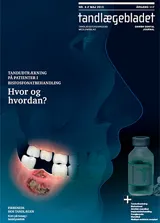Fraktur af den atrofiske mandibel i forbindelse med implantatbehandling
Baggrund
Implantatindsættelse i atrofiske mandibler er i dag en rutinemæssig behandling, men kan i sjældne tilfælde føre til fraktur af mandiblen. Ifølge litteraturen udgør risikoen ca. 0,2 %.
Patienttilfælde
En ældre patient blev henvist til Tand-, Mund- og Kæbekirurgisk Klinik, Rigshospitalet med kæbefraktur efter indsættelse af implantater i den anteriore del af mandiblen. Patienten led af ekstrem alveolær atrofi svarende til mandiblen og fik efterfølgende foretaget åben reponering og osteosyntese af frakturerne i generel anæstesi. Der blev samtidig foretaget ossøs rekonstruktion med knogletransplantat udtaget fra hoftekammen. Frakturen helede ukompliceret.
Konklusion
Implantatbehandling hos tandløse ældre patienter med atrofiske underkæber foretages i dag rutinemæssigt med høj succesrate. I sjældne tilfælde opstår mandibelfraktur. Det er vigtigt, at man er opmærksom på den øgede risiko ved ekstrem atrofi af underkæben, tager relevante forholdsregler og henviser hurtigt, hvis komplikationen skulle opstå.
Fracture of the atrophic mandible associated with implant treatment
Background – Implant insertion in atrophic mandibles is currently a routine procedure, but in rare cases it can lead to fracture of the mandible. According to the litterature the risk is approximately 0.2%. Case study – An elderly patient was referred to the Department of Oral- and Maxillofacial Surgery at Rigshospitalet, with a mandibular fracture after insertion of implants in the anterior part of the mandible. The patient suffered from extreme alveolar atrophy of the mandible and was treated under general anaesthesia with reduction and fixation of the fracture. At the same time, osseous reconstruction was undertaken, using bone grafts from the iliac crest. The fracture healed without complications. Conclusion – Implant treatment of elderly patients with edentulous jaws and atrophic mandible are currently performed routinely with a high rate of success. However, mandible fracture occurs in rare cases. It is therefore important to be aware of the increased risk in mandibles with extreme atrophy, to consider important precautions and to quickly refer if the complication should occur.


